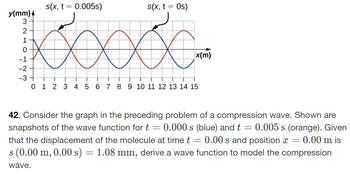Question

Transcribed Image Text:s(x, t = 0.005s)
s(x, t = 0s)
y(mm)4
3
2
1
0
-1
-2
-3+
0 1 2 3 4 5 6 7 8 9 10 11 12 13 14 15
x(m)
=
=
42. Consider the graph in the preceding problem of a compression wave. Shown are
snapshots of the wave function for t 0.000 s (blue) and t 0.005s (orange). Given
that the displacement of the molecule at time t 0.00 s and position x 0.00 m is
=
-
s (0.00 m, 0.00 s) = 1.08 mm, derive a wave function to model the compression
wave.
Expert Solution
This question has been solved!
Explore an expertly crafted, step-by-step solution for a thorough understanding of key concepts.
Step by stepSolved in 4 steps with 11 images

Knowledge Booster
Similar questions
- Two transverse waves travel through a taut string. The speed of each wave is v = 30.0 m/s. A plot of the vertical position as a function of the horizontal position is shown below for the time t = 0.0 s for both waves; one in red and the other in blue.arrow_forwardOrder the following waves by their wave vector. Negative wave vectors are less than positive wave vectors. a) y(x, t) = 4 sin(x - t) b) y(x, t) = 4 sin(-x- - t) - c) y(x, t) = 4 sin(2x - 5t) d) y(x, t) = sin(-2x - t) a) > c) > d) > b) d) >b) > c) > a) c) = d) > a) = b) c) > a) > b) > d) Aarrow_forwardConsider two sinusoidal waves: fi = A1 cos (kz – wt + ø1) and f2 = A2 cos (kz – wt + 02). We can write their complex forms as fi =Aje(kz-wt+61) = áeï(kz-wt) f2 =Aze(kz-wt+62) = Ãze³(kz-wt) where the complex amplitudes Ã1 = Ajeø1 and Ã, = Azeió2 Now suppose we want to combine the two: fs = fi + f2 = Ãze(k3:-w3t) = Azeiøs ei(kzz=wzt) Find expressions for A3, $3, k3, and w3.arrow_forward
- A wave has a wavelength of 30 cm. What is the phase difference between two points on this wave that are 45 cm apart? π/4 rad π/3 rad π/2 rad 2π/3 rad π radarrow_forwardConsider a monochromatic green lightwave with wavelength λ = 550 nm (1 nm = 1 * 10-9m). Assuming the speed of light in vacuum (which is close to the one in air) to be c = 3 * 108m/s, then: A. Calculate the period τ and the optical frequency v for green light? B. Write a sinusoidal harmonic wave with unit amplitude propagating towards the negative x-axis. Consider that for x = 0 and t = 0, the (initial) phase is (π/2). C. Plot the wave profile against x for following times: t = 0, 0.25τ, 0.5τ, and 0.75τ. Assume an arbitrary unit for the y-axis.arrow_forwardD, mm 1 0 00000000 The figure shows two waves traveling in the positive-x direction. The amplitude of the resultant wave is O 1.0 mm. O zero. O 1.8 mm. O 1.4 mm. O 2.0 mm.arrow_forward
arrow_back_ios
arrow_forward_ios